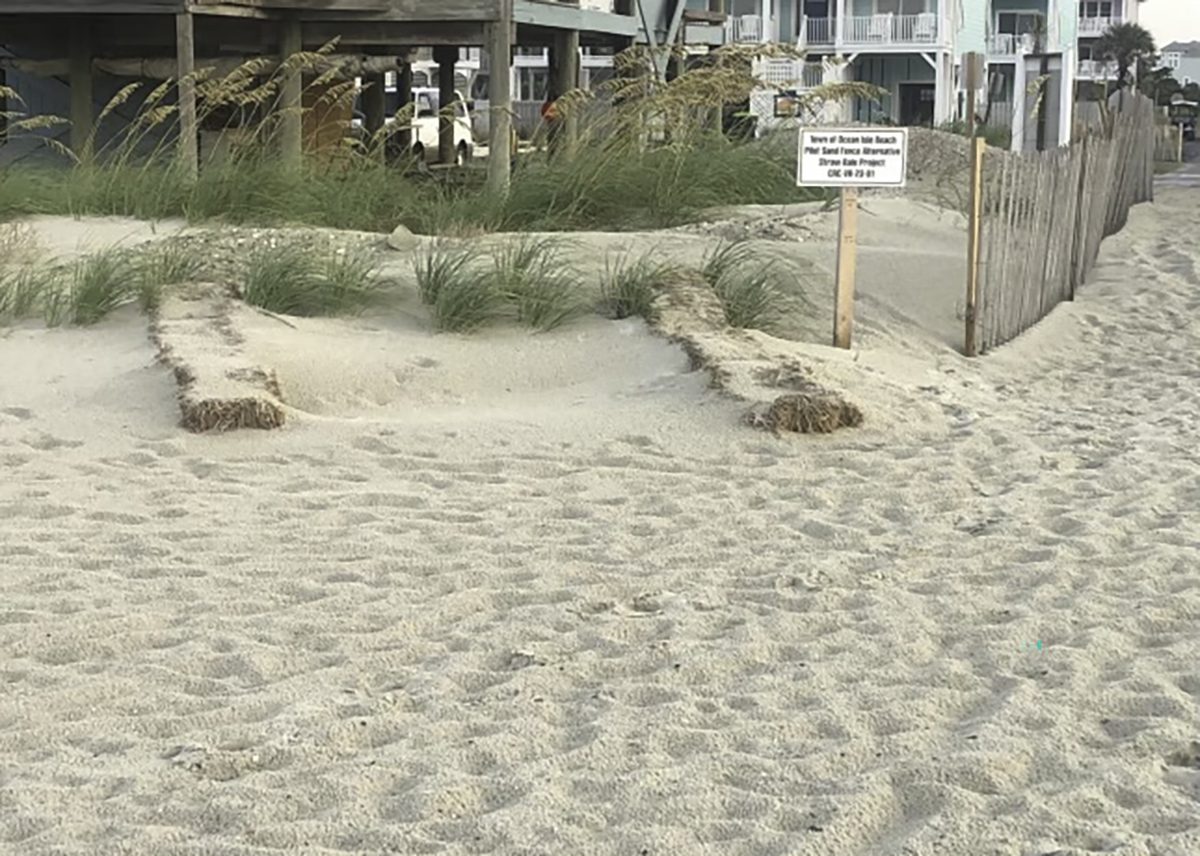
Thorough research needs to be done on how wheat straw bales might affect oceanfront habitat before the state allows them to be used as an alternative to sand fencing, a state wildlife official said.
The North Carolina Wildlife Resources Commission has repeatedly stated its concerns in recent years about straw bales being used as a tool to protect and build up oceanfront dunes, Maria Dunn said in a recent meeting of the state Coastal Resources Commission.
Supporter Spotlight
Dunn, who is with Wildlife Resources Commission’s Habitat Conservation Program, said that the agency understands the desire to try and maintain shorelines, but pointed out what she said are “significant differences” between traditional sand fencing and bales.
“We have not objected to traditional use of sand-fencing material as long as installation was done in a manner to effectively collect wind-blown sand and not impede or block areas of the shore for public use and wildlife habitat,” Dunn said at the coastal commission’s Nov. 13 meeting. “Appropriate installation includes the location along the appropriate area of the beach profile, orientation and alignment of fencing, distance between fencing, and length of fencing down the beach profile.”
The proposed rule change the coastal commission approved in April establishes specific guidelines for where and how bales may be placed on a beachfront.
But the potential impacts to shoreline habitat and the animals, including endangered species and plants, that rely on that sandy habitat, remain grossly understudied, Dunn said.
“It was asked if research was available on how bales impact wildlife resources on habitats on ocean shorelines,” she said. “But since they are not permitted on any other Atlantic shoreline’s state shore there is no research or data available to share with you.”
Supporter Spotlight
The rule amendment was introduced as a way to help save permittees from waiting for sand fencing to become available during times when it is in high demand.
But unlike traditional sand fencing, straw bales could potentially introduce invasive and nonnative ocean shoreline plant species to shores, influence sand temperatures and, when initially installed, take up 48 times the area that traditional sand fencing uses, Dunn said.
Under the proposed rule amendment, bales cannot be placed in sections more than 10 feet long, 2 feet wide and 3 feet high and ties or binding must be removed from the bales. A permittee must repair or remove damaged, nonfunctioning, or bales sections or stakes moved from the alignment in which they were authorized.
Only local governments, state and federal agencies and large, oceanfront homeowners associations would be permitted to use bales.
A state Division of Coastal Management official told the Coastal Resources Commission in August that the division does not expect a significant uptick in the use of straw bales because they tend to cost more than traditional sand fencing, would need to be replaced more frequently than fencing, and the verdict is still out on how efficiently bales trap sand.
Ocean Isle Beach became the first in the state to test straw bales on a portion of its ocean shore in 2023.
Ocean Isle Beach Mayor Debbie Smith told Coastal Review in late August that the bales worked well, were cheaper than sand fencing and easily accessible during a time when the town could not get sand fencing because of high demand.
Dunn said that the town’s pilot program was monitored by little more than photographic documentation and some surface temperature readings.
There was no designed, controlled experiment comparing different bale installments to traditional sand fencing to see which application best collected windblown said, she said.
“We would recommend that such an experiment is designed with input from state and federal agencies to determine the best type of sand management tools to collect sand for dune structure while minimizing impacts to wildlife resources,” Dunn said.
Smith said in a telephone interview Tuesday afternoon that she never saw a Wildlife Resources Commission representative visit the island to check sand temperatures at turtle nests or conduct other monitoring.
“On any decision we have to make we can always say ‘what if,’” Smith said. “She has no evidence of some of those what-ifs. I don’t think anybody wants to do any environmental damage.”
The town is working on a dune project that will begin sometime this winter. Since the proposed rule amendments have not been made formative, the town has opted to use traditional sand fencing “to move our project along and get it permitted,” Smith said.
Sand temperatures play a significant role in determining the sex of sea turtles in a nest. Dunn said that a half-degree variation can change how many males or females are within a nest and possibly whether a nest remains viable.
Temperatures were not taken at sea turtle nest cavity depths in Ocean Isle Beach, she said.
“We don’t want to artificially create more females,” said Deb Allen, Ocean Isle Beach Sea Turtle Protection Organization coordinator. “We need a balance of males to females.”
Allen pointed to studies that show when nests incubate at higher temperatures it can affect the physical and cognitive abilities of hatchlings, slowing them in their ability to make it from the shore to the ocean.
“We want them to come out of that nest and we want them to crawl to that ocean as fast as possible,” she said.
The coastal commission in August unanimously approved the fiscal impact analysis of the proposed rule. The fiscal analysis measures how a rule may affect a government’s revenue and expenditures to help prepare for or prevent budget shortfalls.
The North Carolina Department of Environmental Quality, or DEQ, and Office of State Budget and Management also approved the fiscal analysis.
A public hearing on the proposed amended rule was held Oct. 30 in Morehead City. The public comment period on the rule ends December 2.
The division has not yet received comments from the U.S. Fish and Wildlife Service, according to its public information officer, Christy Simmons.
The wildlife service did not respond to a request for comment in time for publication.
Division officials anticipate that the amended rule will become effective April 1, 2025.







